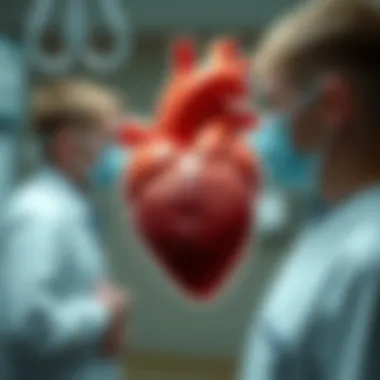Terminal Heart Conditions: Complexities and Care


Intro
Terminal heart conditions are a profound and intricate part of the medical narrative. These conditions, often cloaked in complexity, represent not merely a diagnosis but a flooding of emotions, ethical dilemmas, and a swirling cloud of questions. For students, researchers, educators, and healthcare professionals, gaining a thorough understanding of these conditions is crucial, as they spawn both critical clinical challenges and emotional realities for patients and families alike.
These illnesses go beyond the mere physical manifestations found on an EKG or in a lab report. They encapsulate a range of factors—genetic predispositions, lifestyle choices, and environmental influences. The reality of a terminal heart condition does not solely reside within the patient’s body; it seeps into their lives, affecting families and broader social relationships. The notion of heart disease being merely a clinical concern disintegrates when faced with the emotional, psychological, and ethical ramifications that accompany such a diagnosis.
When considering the complexities involved, one might ponder: how did we reach this juncture in medical science, and what does it entail for the future? This narrative lays the groundwork for exploring these nuances, providing insight into the labyrinthine characteristics of terminal heart conditions and the surrounding care strategies. Through this lens, we can aspire to foster informed discussions that illuminate the challenges each individual might face during this intricate journey.
Intro to Terminal Heart Conditions
Understanding terminal heart conditions is essential not only for individuals grappling with these challenges but also for the healthcare professionals guiding them. As heart diseases persist as leading contributors to global morbidity and mortality, delving into their complexities is vital. A comprehensive grasp of these issues provides a framework for informed decision-making and empathetic patient care, underlining the necessity of effective communication between all parties involved.
Understanding Heart Diseases
Heart diseases encompass a wide spectrum of disorders that affect the heart's function. These include coronary artery disease, heart rhythm problems, heart valve issues, and congenital heart defects, to name a few. The intricacies involved in heart health can be baffling. For example, coronary artery disease can stem from a buildup of plaques that may lead to angina or even heart attacks. Heart rhythm disorders, such as atrial fibrillation, can complicate matters further by increasing the risk of stroke.
It's notable that heart diseases don't discriminate; they can affect anyone regardless of age or background. Growing evidence highlights that environmental factors, lifestyle choices, and genetics all play a critical role in the development and progression of these diseases.
Additionally, the need for continuous education and awareness around heart health remains pressing. A quick look at physical activities, nutrition, and stress management can illuminate not only protective factors but also red flags to heed.
Defining Terminal Conditions
When one speaks of terminal conditions, it generally refers to diseases that are incurable or irreversible and often lead to death in the foreseeable future. Terminal heart conditions specifically signify severe diseases that greatly impair quality of life and signal a narrowing window for treatment options.
Terms like "end-stage heart failure" or "advanced ischemic heart disease" may come up in conversation, often evoking anxiety and fear. The emotional weight of such diagnoses cannot be overstated. These conditions necessitate a multi-faceted understanding that blends medical knowledge with compassion.
Family support, mental health considerations, and informed consent all play crucial roles in this context. Knowing that a heart condition is terminal shapes not just treatment pathways but also personal and familial dynamics.
Understanding the emotional and clinical facets of terminal heart conditions informs better treatment and emotional preparedness for both patients and their families.
Engaging with terminal heart conditions also opens up avenues for discussing emerging therapies, holistic approaches, and the ethical dilemmas surrounding end-of-life care. The intricate nature of these topics reflects their profound importance and requires nuanced consideration from all involved.
Types of Terminal Heart Conditions
Understanding the various types of terminal heart conditions is vital in grasping not only the medical intricacies involved but also the broader implications for patients and their families. Each type presents unique challenges and manifestations that require tailored approaches for management and care. Furthermore, recognizing these distinctions can empower healthcare providers, patients, and support systems to engage in informed conversations about treatment options and expectations.
Congestive Heart Failure
Congestive heart failure (CHF) stands out as one of the leading terminal heart conditions. This condition doesn't imply the heart has stopped beating but rather that it's unable to pump blood efficiently. Imagine a busy highway that suddenly encounters a blockade; traffic backs up, and commuters get delayed. In CHF, blood flow becomes hindered, causing a backlog and congestion in various parts of the body.
Symptoms of CHF can vary widely. Patients may experience shortness of breath, fatigue, and swelling in the legs or abdomen, notably impacting their daily activities. Managing CHF often involves lifestyle changes, medications to improve heart function, and sometimes surgical interventions. The goal here is to enhance life quality and reduce hospitalizations, which can often be a burden for both patients and their loved ones.
Cardiomyopathy
Cardiomyopathy refers to diseases of the heart muscle that can lead to its weakening. Thw accompanying symptoms can range from mild to severe, leading up to potential heart failure. There are several forms, including dilated, hypertrophic, and restrictive cardiomyopathy, each with distinct characteristics. For example, dilated cardiomyopathy causes the heart chambers to enlarge, which could be visualized as stretching a balloon—once it’s expanded too much, it loses its capacity to function effectively.
Patients with cardiomyopathy may experience irregular heartbeats, dizziness, and swelling, which can contribute to feeling isolated as they navigate discomfort. Treatments typically involve lifestyle adjustments, medication, and sometimes devices or surgery aimed at managing the condition and enhancing the heart’s performance.
Ischemic Heart Disease
Ischemic heart disease (IHD) emerges from a narrowing of the heart's arteries, often due to a buildup of fatty deposits, which limits blood supply. Picture a garden hose pinched in the middle; the water flow weakens. This analogy reflects how blood flow to the heart muscle is compromised, potentially leading to angina or heart attacks.
Many individuals living with IHD face an uphill battle marked by chest pain and breathlessness, especially during physical exertion. Managing this condition involves a multifaceted strategy, including medications, lifestyle modifications, and possibly surgical methods like angioplasty or bypass surgery to restore adequate blood flow. Education about symptoms and triggers is essential for both patients and their families to recognize when immediate medical attention might be necessary.
Arrhythmias
Arrhythmias characterize irregular heartbeats, which can manifest as the heart racing, skipping beats, or beating too slowly. Think of this condition as a music band going out of sync during a performance, where the rhythm falls apart. Patients may feel palpitations or dizziness, sometimes leading to fainting spells or complications.
Arrhythmias can develop from a range of factors, including heart damage, electrolyte imbalances, or excessive caffeine. Treatment varies based on the type and severity but can include medications, lifestyle modifications, and interventions like ablation therapy or implantable devices. Understanding the triggers can be pivotal in managing these symptoms and ensuring a better quality of life overall.
"Knowledge is power, but it is not the only thing. Understanding your condition helps alleviate some of the anxiety that comes with terminal diagnoses."
Underlying Causes of Terminal Heart Conditions
Understanding the underlying causes of terminal heart conditions is crucial in grasping their complexity. This topic not only sheds light on the roots of these dire health issues but also offers insight into potential prevention and management strategies. By identifying the causative factors, healthcare providers can tailor interventions and educate patients more effectively. A focus on underlying causes enables us to appreciate the multifaceted nature of heart disease and the interplay of genetics, lifestyle, and existing health conditions which can influence outcomes significantly.
Genetic Factors
Genetic predisposition plays a pivotal role in heart disease. Individuals may inherit specific genes that increase their likelihood of developing terminal heart conditions, such as familial hypertrophic cardiomyopathy. This condition, often masked until later in life, can lead to sudden cardiac arrest, particularly in athletes. Moreover, many prevalent heart diseases, like ischemic heart disease, have significant hereditary components. For instance, if a person has a family history of heart disease, their risk profile automatically escalates. Recognizing this can be invaluable. Individuals with a family background of heart issues should consider more rigorous monitoring and preventative strategies.
"Understanding one's genetic background can be the first step towards proactive health management."
Lifestyle and Environmental Influences
Beyond genetics, lifestyle choices and environmental conditions shape heart health considerably. High-sugar diets, lack of physical activity, and smoking are harmful habits that pile on risk factors. In fact, studies show that obesity resulting from poor dietary habits is a precursor to many terminal heart diseases. Additionally, exposure to environmental pollutants has been linked to increased risks of cardiovascular problems. Living in regions with poor air quality can trigger conditions like asthma or chronic obstructive pulmonary disease, which indirectly stress the cardiovascular system. This reinforces the idea that heart health isn't just about hereditary risks; understanding and modifying lifestyle choices could have profound implications.
Providing education about healthier eating, engaging in regular physical activity, and mitigating exposure to harmful pollutants is critical. It not only empowers individuals but can also positively impact community health outcomes.
Chronic Health Conditions


Chronic health conditions frequently intertwine with terminal heart diseases, exacerbating their severity. Conditions like diabetes can significantly increase one's risk for heart disease, acting like a double-edged sword. Not only does diabetes damage blood vessels over time, but it also influences behaviors, such as irregular eating patterns, and can contribute to obesity. Hypertension, another common chronic condition, can gradually wear down the heart muscle, leading to congestive heart failure if not managed well.
Thus, a multifaceted approach is necessary for managing terminal heart disease. Individuals living with chronic conditions need holistic healthcare that addresses both their heart and their other health issues. Collaboration among healthcare providers ensures that all aspects of a patient’s health are considered, offering a pathway towards improved outcomes.
In summary, considering the underlying causes of terminal heart conditions involves a nuanced exploration of genetic, lifestyle, and chronic health factors. Each of these components weaves into the fabric of heart health, underscoring the need for a comprehensive understanding of how they interact. This knowledge ultimately supports strategies for better prevention and management of terminal heart conditions.
Physiological Implications
Understanding the physiological implications of terminal heart conditions is crucial for both healthcare providers and patients alike. These implications extend beyond the heart itself, affecting various body systems and influencing overall health. When terminal heart conditions are diagnosed, they present not only a challenge in terms of medical management but also a profound impact on the patient’s quality of life. By delving into the specific elements and considerations, we can better appreciate the far-reaching effects of these serious health issues on individual well-being.
Impact on Cardiovascular Function
Terminal heart conditions wreak havoc on cardiovascular function, reshaping how the heart operates and interacts with the body. Conditions like congestive heart failure, for instance, can lead to significant reductions in the heart's pumping effectiveness. This can cause the heart to work overtime just to maintain basic circulation. As a consequence, patients may experience fatigue, shortness of breath, and swelling in the extremities due to fluid buildup.
- The body struggles to supply enough oxygenated blood to vital organs,
- This often results in organ dysfunction, which could potentially be irreversible.
- Patients might also encounter increased heart rates as the heart compensates for its impaired abilities.
Such physiological alterations mean that managing these conditions requires a multifaceted approach. Physicians might prescribe medications designed to improve heart function or employ devices to assist in circulation. However, understanding the individual’s unique response to treatment is paramount. Monitoring through regular check-ups can help tailor interventions to the evolving needs of the patient.
The interplay between heart function and systemic health cannot be understated; a failing heart impacts more than just itself.
Systemic Effects of Terminal Heart Conditions
When one considers terminal heart conditions, it is essential to recognize their systemic effects — they do not merely remain localized to the cardiovascular system. The heart's failure can trigger a cascade of issues affecting multiple organ systems. For example,
- Kidneys: Reduced cardiac output can lead to decreased kidney perfusion, which harms renal function over time. If the kidneys are not able to filter blood adequately, this can lead to worsened fluid retention and elevated blood pressure, further straining the heart.
- Liver: Poor circulation can result in hepatic congestion, adversely impacting liver metabolism and possibly leading to liver dysfunction.
- Lungs: Pulmonary congestion may arise from heart failure, making it difficult for patients to breathe, especially during exertion or when lying flat.
Side effects aren’t just physical; emotional and cognitive impairments can develop as well. Patients might face confusion or altered mental status due to the metabolic changes happening within their bodies. Understanding these systemic effects offers a comprehensive view of the challenges faced by individuals with terminal heart conditions.
In summary, grasping the physiological implications of terminal heart conditions reveals how interconnected human systems are. Learning how heart failure influences other organs helps in building patient-centered care strategies. Together, as healthcare professionals and families, we can foster a supportive environment that acknowledges the pervasive nature of these conditions.
Diagnostic Approaches
When it comes to terminal heart conditions, the need for precise and timely diagnostic approaches cannot be overstated. The stakes are high; effective diagnosis not only influences treatment decisions but also shapes the experiences of patients and their families. This section delves into the crucial methodologies employed in diagnosing these complex conditions, providing insights into their impact and importance.
Clinical Evaluations
Clinical evaluations are the bedrock of diagnosing terminal heart conditions. These evaluations typically start with a thorough medical history of the patient, laying a foundation for understanding their risk factors and symptoms. Clinicians often ask questions like:
- Have you experienced chest pain or shortness of breath?
- Do you have a family history of heart diseases?
- Are there underlying health issues like diabetes or hypertension?
A clinician's initial observations during a physical examination reveal essential information. Listening to heart sounds can uncover murmurs or irregular rhythms, while observing the patient's overall condition can indicate heart failure or distress. These evaluations are not merely a formality; they provide vital clues, helping to form a picture of the heart's function.
Imaging Techniques
In the world of diagnostics, imaging techniques serve as the eye into the heart’s intricate workings. Tools like echocardiograms and MRIs uncover structural abnormalities that might otherwise go unnoticed. An echocardiogram, for instance, is invaluable for assessing heart function and anatomy without the invasiveness of surgery. The ultrasound waves produce real-time images, offering a window into how well the heart is pumping and identifying issues such as valve dysfunction or cardiomyopathy.
Additionally, computed tomography (CT) scans can visualize the coronary arteries, offering insights into blockages that could precipitate severe conditions. These scans have revolutionized how physicians diagnose problems, allowing them to make well-informed decisions based on visual evidence.
Laboratory Tests
Laboratory tests round out the diagnostic toolbox. Blood tests provide crucial biomarkers for heart conditions. For instance, a high level of troponin can indicate damage to the heart muscle, while B-type natriuretic peptide (BNP) levels help assess heart failure severity. Using these markers, healthcare providers can gauge the extent of heart damage and customize treatment plans accordingly.
Further laboratory evaluations might include lipid profiles to analyze cholesterol levels, which can be decisive in determining the risk of ischemic heart disease. By systematically analyzing these lab results, doctors gain a clearer picture of not just the patient's current state but also potential future challenges.
Comprehensive diagnostic methods play a pivotal role in managing terminal heart conditions, ensuring no stone is left unturned in the pursuit of effective care.
The integration of these approaches helps ensure that patients receive both timely and accurate diagnoses, vital for initiating the right treatment plan. With advancements in diagnostic technology, we can look forward to even better outcomes for those grappling with terminal heart conditions.
Treatment Options
Understanding treatment options for terminal heart conditions is essential. These options can shape not only the quality of life but also the experience of patients and their families during a challenging time. In this section, we'll explore various methods, their significance, and considerations that come into play when devising a treatment plan.
Pharmacological Interventions
Pharmacological interventions play a crucial role in managing terminal heart conditions. Medications can alleviate symptoms, improve function, and enhance the quality of life. Beta-blockers, for instance, are often employed to reduce strain on the heart, while angiotensin-converting enzyme (ACE) inhibitors help in managing heart failure by reducing fluid retention.
Key Benefits:
- Symptom Relief: Effective management of symptoms like shortness of breath or chronic fatigue.
- Medication Adherence: Many patients find pharmacological solutions easier to integrate into their daily routines compared to surgical options.
- Accessibility: Medications can be prescribed and managed in outpatient settings, reducing the need for hospital visits.
However, several considerations must be addressed:
- Side Effects: While medications can be life-saving, they also come with potential side effects, like dizziness or increased heart rate.
- Individual Variability: Each patient has a unique response to medications, which necessitates regular monitoring and adjustments.
- Complex Regimens: For some patients, managing a complex medication regimen can become overwhelming.
Surgical Procedures
Surgical interventions can be life-altering but often carry more risk compared to pharmacological solutions. For terminal heart conditions, surgeries like coronary artery bypass grafting (CABG) or heart transplants might be considered, albeit with careful deliberation on their appropriateness and timing.
Considerations:


- Eligibility: Not all patients may qualify for surgery based on their overall health status or the progression of their heart disease.
- Recovery Time: Surgical options often involve extended recovery periods, which may not be feasible for every patient.
The decision to proceed with surgery is not merely technical; it often involves significant emotional and ethical assessments.
Benefits:
- Potential for Improved Quality of Life: Surgery can sometimes restore considerable function and extend life expectancy.
- Address Underlying Issues: For some patients, addressing the mechanical aspects of heart failure can lead to notable improvements.
Palliative Care Strategies
Palliative care is a fundamental aspect of managing terminal heart conditions. It prioritizes comfort and quality of life over aggressive treatments, which may not be beneficial at this stage. This can involve managing pain, providing emotional support, and assisting families in understanding the journey ahead.
Features of Palliative Care:
- Holistic Addressing of Needs: Care is tailored not only to physical symptoms, but also emotional and spiritual needs.
- Supportive Environment: Family members receive guidance and support to help them cope with their loved one’s condition.
- Interdisciplinary Approach: Teams often include doctors, nurses, social workers, and chaplains, ensuring well-rounded support.
Palliative approaches do not indicate abandonment of care but rather a shift in focus to enhance the patient’s comfort and dignity as they navigate the complexities of their terminal condition.
Psychological Considerations
The realm of psychological considerations is of great significance when discussing terminal heart conditions. These conditions often bring forth a tidal wave of emotional turmoil, impacting not just the patients, but also their loved ones. Understanding these psychological elements can pave the way for better care and support, recognizing that heart health does not merely encompass the physiological aspects but also the mental and emotional landscapes that patients traverse.
Emotional Responses
Emotions run rampant when one faces the reality of a terminal heart condition. Anguish, anxiety, anger, and fear can bubble to the surface, each sentiment manifesting in different ways. The feeling of dread can be overwhelming. It's crucial to recognize that such reactions are not signs of weakness or failure but are instead normal responses to an extraordinary situation. Each patient may respond differently, influenced by their personal history, coping mechanisms, and the support network they possess.
- Anger may stem from feelings of helplessness, leaving the patient feeling frustrated with both their condition and their body.
- Depression often follows a diagnosis; living with the pervasive uncertainty can weigh heavily, clouding one's ability to find joy in life.
- Anxiety can flare up when contemplating the implications of a terminal diagnosis; worries about the future and the end of life can become all-consuming.
- Guilt may also arise, particularly in patients who feel they are burdening their families or haven’t taken enough care of their health in the past.
It can be beneficial to create an environment where patients can freely express these feelings. Having open channels for communication provides a platform for acknowledgement and healing.
Counseling and Support Needs
Addressing the psychological burden of terminal heart conditions necessitates tailored counseling and robust support systems. Patients often find themselves lost in the sea of emotions they face. Here’s where professional guidance becomes invaluable.
- Professional Counseling: Therapists and trained counselors can offer the necessary coping strategies and emotional tools that patients and families need during challenging times. They can help navigate the turbulent waters of grief, fear, and uncertainty.
- Support Groups: Connecting with others who share similar experiences can greatly diminish feelings of isolation. Such groups foster an environment where patients can share stories, exchange ideas, and even laugh together in the face of adversity. This sense of community can lighten the burden of illness.
- Family Involvement: Including family members in counseling sessions can also be beneficial. It helps everyone involved to understand the emotional challenges faced by the patient, creating a more supportive atmosphere.
"Understanding the emotional landscape of terminal illness can significantly enhance the quality of end-of-life care, making each moment count during these crucial times."
In short, the mental aspects of terminal heart conditions cannot be overlooked. The journey through this difficult phase is as much about emotional well-being as it is about physical health. By putting resources in place to address these needs, we pave the way not just for better medical outcomes but also for a more meaningful engagement with life itself.
Further resources on emotional support for those with terminal heart conditions can be found at American Heart Association, National Institutes of Health, and Mayo Clinic.
Ethical Dilemmas
The topic of ethical dilemmas is of paramount importance when discussing terminal heart conditions. In the face of life-altering diagnoses, patients and families are often thrust into a realm of difficult choices that can influence their quality of life, emotional well-being, and overall care. This section aims to delve into specific ethical concerns and frameworks surrounding decisions that often accompany terminal heart diseases, particularly focusing on end-of-life care and patient autonomy. Understanding these ethical considerations is crucial for healthcare providers, patients, and families as they navigate the complex landscape of terminal heart conditions.
Decisions Around End-of-Life Care
When it comes to end-of-life care, many factors come into play. It's about weighing the options and understanding the implications of each decision made. In situations where cure is not an option, the conversation shifts to ensuring comfort and dignity in the remaining time. Notably, those affected often face the tough choice of whether to pursue aggressive treatment strategies or to consider palliative care focused on quality of life.
One key aspect is discussing advanced directives or living wills, which articulate a patient's wishes regarding treatments they do or do not want. This is particularly significant as it empowers patients to have a say in their care, relieving family members from bearing this responsibility. Factors to consider may include:
- Quality of Life: Patients need to determine what kind of experience they want in their final days. For example, many individuals prioritize being at home surrounded by loved ones rather than in a hospital undergoing treatments which might not improve their condition.
- Emotional and Spiritual Support: Conversations about faith or beliefs regarding the end of life can heavily influence decisions. Families should be encouraged to incorporate their loved ones' values into the care plan, ensuring that emotional needs are met alongside physical comfort.
- Financial Considerations: The cost of care can also present a significant dilemma. Discussions should include not only the healthcare costs but also the potential financial burden on families.
Patient Autonomy and Informed Consent
The concept of patient autonomy is at the heart of ethical healthcare practice, particularly in terminal situations. Patients have the right to make informed choices about their treatment options. This involves providing clear, understandable information regarding their condition, the potential outcomes, and the risks involved in each choice.
In the context of terminal heart conditions, informed consent is especially vital because decisions can lead to profound implications. It is essential healthcare providers respect and uphold these rights by ensuring that patients:
- Understand Their Condition: Clear communication about the diagnosis and prognosis can aid patients in understanding the gravity of their situation and the trajectory of their disease.
- Explore All Options: Patients should be made aware of every available treatment modality, including clinical trials or alternative therapies, ensuring they can make a fully informed decision.
- Review Decisions Regularly: As conditions can change rapidly, it’s important to revisit treatment decisions to gauge effectiveness and adapt to new circumstances. In this way, patients remain engaged and empowered in their healthcare journeys.
Engaging in honest dialogues about their treatment preferences can make a world of difference for both patients and their families, fostering a sense of control in an uncontrollable situation.
In summary, navigating ethical dilemmas in terminal heart conditions is an intricate process that calls for careful consideration of patient wishes, family dynamics, and the broader implications of medical choices. By prioritizing ethical standards and fostering respectful conversations, we can hope to ease the journey for those facing such profound challenges. For further exploration of these topics, resources available at National Institute of Health and American Heart Association can provide additional insights.
Family Dynamics
Understanding family dynamics is crucial when navigating the landscape of terminal heart conditions. The implications of such diagnoses reverberate far beyond the individual patient. Families often find themselves at the center of an emotional whirlwind, facing stressors that challenge their resilience and cohesion. The way family members interact, communicate, and support each other can significantly affect not only the well-being of the patient but also the collective healing process of the entire family unit.
Impact on Families
When a loved one receives a terminal heart diagnosis, the emotional terrain can be rough. Members of the family may experience a range of feelings including grief, anxiety, and helplessness. For instance, siblings might grapple with jealousy or resentment if they feel that they are not receiving as much attention as the affected family member. Parents often feel a heavy burden of guilt or regret, questioning whether they could have done something different to alter the course of their loved one’s health.
This emotional turbulence can lead to significant shifts in family roles and responsibilities. For example, one sibling may take on the role of the primary caregiver, often at the expense of their own mental health, while others may withdraw as a coping mechanism. These changes can lead to misunderstandings or conflict, as family members struggle to communicate their needs and emotions effectively.
"The dynamics of a family can change overnight, making it essential to address communication patterns as soon as possible.”
Moreover, financial stress due to medical bills can further strain familial relationships, with discussions around healthcare costs becoming a sensitive topic. Navigating these various pressures calls for a strong support network within the family, where open dialogue is encouraged to foster a shared understanding and collective problem-solving.


Family Support Systems
Establishing robust support systems is pivotal for families dealing with terminal heart conditions. These systems may include emotional support from immediate family members, as well as extended family, friends, and even community resources. Creating a network allows family members to feel less isolated in their struggles, fostering a sense of solidarity that is often needed during tumultuous times.
Elements of Effective Support Systems:
- Open Communication: Sharing feelings, worries, and experiences promotes trust and reduces misunderstandings. Regular family meetings can help in airing grievances or discussing caregiving tasks.
- Seeking Outside Support: Many families benefit greatly from involving professionals such as social workers or counselors who specialize in end-of-life care. Such professionals can provide insights and strategies for managing conflict and stress.
- Utilization of Support Groups: Joining groups specific to terminal heart conditions can provide families with insights from others who have faced similar situations.
- Education and Resources: Understanding the condition better helps families manage expectations. Educational resources can be found on websites such as American Heart Association and Mayo Clinic, which can equip families with the information needed to make informed decisions.
These support structures serve not merely to assist in the practical aspects of caregiving but also to provide emotional reassurance. The feeling of "not being alone" can make a world of difference, helping families cope with the realities of terminal illness. The emphasis on connection can foster healing experiences that underscore the importance of mutual understanding and compassion in times of crisis.
Long-Term Prognosis
In the discourse surrounding terminal heart conditions, understanding the long-term prognosis is vital. It offers a lens through which patients, families, and healthcare providers can grasp the potential outcomes of such conditions. This section digs into the nuances of survival rates and the factors influencing them, ultimately aiming to demystify the often daunting future that patients face after a terminal diagnosis.
The long-term prognosis for individuals diagnosed with terminal heart conditions serves as more than just a statistical number; it reflects an intricate interplay of medical, psychological, and social factors. It helps families brace themselves for what’s ahead and also plays a significant role in the decision-making processes within clinical settings. The benefits of grasping the long-term prognosis can hardly be overstated. Patients may find clarity in understanding the trajectory of their health, which can significantly influence their choices regarding treatment options and palliative care strategies. Moreover, this knowledge enables families to prepare emotionally and even financially, as the journey through terminal heart conditions can be both taxing and complex.
Survival Rates and Patterns
Survival rates for terminal heart conditions often vary considerably based on numerous elements, including the specific type of heart disease, the patient’s age, overall health, and the timeliness of medical interventions. Research highlights notable discrepancies in survival trends, often influenced by advancements in medical technology and treatment methodologies. The following points offer insight into patterns that have emerged in the field:
- Age Factor: Younger patients generally present with better prognosis metrics compared to older adults. The intersection of longevity and chronic cardiovascular diseases poses distinct challenges.
- Condition-Specific Rates: For example, individuals with congestive heart failure may experience different survival outcomes than those diagnosed with ischemic heart disease. While some might manage to live several years after diagnosis, others may have a more limited life expectancy.
- Comorbidities: The presence of additional health issues such as diabetes or chronic kidney disease can further complicate survival, creating a layered challenge in the care process.
- Access to Care: Geographical disparities in healthcare access can greatly influence survival rates. Patients in urban centers often have better access to specialized care compared to those in remote locations.
"A prognosis is more than mere numbers; it’s a navigation tool through uncharted waters, guiding patients, families, and healthcare providers alike in moments of uncertainty."
It is essential to note that survival rates are not written in stone. They provide a statistical framework, but each individual’s journey can diverge substantially based on personal circumstances and decision-making.
Patient Advocacy
Understanding the intricacies of terminal heart conditions requires not only medical expertise but also a strong advocacy framework that empowers patients and their families. Patient advocacy plays a vital role in navigating the complexities associated with terminal diseases, ensuring that the voices of those affected are heard and considered in treatment decisions. There are several key benefits and considerations that highlight the importance of patient advocacy in this context.
Role of Advocacy Groups
Advocacy groups serve as essential bridges between patients, healthcare providers, and policymakers. These organizations provide a collective voice for those dealing with terminal heart conditions, helping to drive awareness and education about the challenges patients face.
- Providing Information: Advocacy groups often circulate informative materials that cover various heart conditions, offering insights into symptoms, treatment options, and coping strategies.
- Engaging with Policymakers: These organizations routinely collaborate with health authorities to influence policy changes that promote patient welfare and access to critical care services.
- Support Networks: Many advocacy groups create forums for patients and families to share experiences and support each other, which can be particularly beneficial during challenging times.
Through these activities, advocacy groups gather vital insights into the issues patients encounter, thereby shaping better healthcare practices and policies. Their collective actions can lead to systematic changes that benefit not just individuals but communities as a whole.
Empowering Patients Through Education
Education stands at the forefront of patient empowerment. In the context of terminal heart conditions, informed patients are better equipped to make decisions about their care, engage with their healthcare providers, and advocate for their own needs. Here are some pivotal aspects:
- Understanding the Condition: In-depth knowledge about one’s diagnosis helps demystify the often overwhelming medical jargon associated with heart diseases. This clarity fosters greater involvement in one’s treatment plan.
- Navigating Healthcare Systems: Education about healthcare navigation—understanding insurance options, treatment coverage, and patient rights—empowers patients to seek the necessary resources and support effectively.
- Enhancing Communication: Educated patients are more likely to communicate their needs to healthcare providers clearly, ensuring that their concerns are addressed, and they receive personalized care.
- Building Support Systems: Educational initiatives often highlight the value of support networks, encouraging patients to reach out and build personal connections with others facing similar challenges.
By promoting a culture of education, advocacy groups not only equip patients with the tools to navigate their healthcare journey, but they also foster a sense of agency that is crucial for improving patient outcomes.
Education is a powerful tool that enables individuals to advocate for themselves and receive appropriate care, making it a cornerstone of patient advocacy.
For further reading on the impacts and initiatives of advocacy groups related to heart health, you can visit the American Heart Association and explore their extensive resources and community support.
Future Directions in Research
The landscape of terminal heart conditions is ever-evolving, driven by advancements in medical science and technology. As we delve into this facet of healthcare, it’s crucial to recognize the importance of ongoing research in understanding, diagnosing, and treating these complex diseases. Research not only enhances our comprehension of the mechanisms behind heart conditions, but also paves the way for significant improvements in patient outcomes. By embracing future directions in research, we aim to unravel the intricacies involved in heart diseases and ultimately improve quality of life for patients.
Innovations in Treatment
In the arena of treatment, innovations are frequently surfacing, propelling the standard practices toward more effective solutions. For instance, gene therapy has begun to make waves in cardiac care, allowing for targeted treatment of hereditary heart conditions. Researchers are exploring techniques such as CRISPR to potentially edit genes associated with heart diseases. This could change the game, perhaps reducing the need for reliance on traditional medications that may only manage symptoms rather than address the root causes.
Moreover, wearable technology is leading the charge in personalized care. Devices that continuously monitor heart rate and rhythms can alert patients and healthcare providers to irregularities in real time. This immediacy can lead to prompt interventions that, at times, may prevent severe complications or hospitalizations.
"The key to revolutionary treatments often lies in the exploration of unconventional pathways."
Furthermore, advancements in cardiac surgery, including minimally invasive techniques, have transformed surgical outcomes. The development of robotic-assisted surgeries allows for precision and reduced recovery times, making cardiac surgery more accessible and less daunting for patients. As these treatment innovations unfold, they promise not only to enhance survival rates but to significantly elevate the standard of care.
Advancements in Diagnostics
On the diagnostic front, strides are being made that sharpen our ability to identify terminal heart conditions earlier and with greater accuracy. Advanced imaging technologies, such as high-resolution echocardiography and cardiac magnetic resonance imaging (MRI), are enabling clinicians to visualize the heart's structure and function with remarkable clarity. This enhanced ability facilitates timely and accurate diagnoses, which are crucial in managing terminal heart diseases effectively.
Additionally, the integration of artificial intelligence in data analysis is revolutionizing diagnostics. AI algorithms are being trained to interpret vast amounts of echocardiographic data, identifying patterns that may go unnoticed by the human eye. This can significantly improve diagnostic accuracy, allowing for tailored treatment plans that align more closely with the patient’s unique situation.
Closure
The conclusion of this article serves as a vital juncture in the understanding of terminal heart conditions. Not only does this section synthesize the discussions that have taken place, but it also draws attention to the multifaceted ramifications these conditions have on patients, families, and healthcare providers alike.
Reflecting on the nature of terminal heart conditions, one can't help but consider how interconnected all aspects are—from diagnosis to treatment options and beyond. Patients are not merely statistics; they are individuals with unique experiences, emotions, and circumstances. It's imperative to recognize that terminal heart conditions encompass a spectrum of physical and psychological struggles that warrant compassionate and tailored approaches.
When one contemplates the importance of patient care, it becomes clear that understanding extends beyond clinical practices. Advocating for effective communication between healthcare teams and patients forms the backbone of comprehensive care. This includes meaningful conversations about prognoses, treatment options, and perhaps most importantly, end-of-life considerations. By fostering an environment of openness and trust, healthcare providers can empower patients to make informed decisions about their care.
Furthermore, this article has highlighted the significance of strong support systems. Families play an essential role in navigating the emotional landscape of terminal heart conditions. Importantly, the ethical dilemmas that arise during this journey require thoughtful engagement, ensuring that patient autonomy remains a priority. Acknowledging and addressing these concerns is crucial for holistic care.
In sum, the conclusions drawn herein reflect the importance of integrating care strategies, emotional support, and ethical considerations into the management of terminal heart conditions. With advancements in research and treatment on the horizon, continued dialogue among healthcare providers, families, and patients is essential for fostering resilience and dignity in the face of terminal illness.
"In the end, it’s not the years in your life that count. It’s the life in your years." – Abraham Lincoln
By illuminating these complexities and implications, this article strives to foster a greater understanding that can enhance the quality of life for patients grappling with terminal heart conditions, paving the way towards a more compassionate approach to care.



